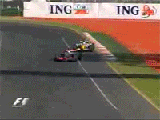cossie wrote:The IRl had dodged this bullet for 16 years, the number of times that car( chassis) had taken flight was the norm, you are looking at about 20 seperate incidents that car has taken flight even without tocking another car, such as Mario's 10 piont landing at Indy, Dario wner to Nascar stating he felt the cars were unsafe and prone to having to call the FAA for takeoff permission, so no this was known for 16 fricking years that the cars was unsafe , prone to taking off and then rotating while in the air, this time however they could not dodge the big bullet, and thusly a fatality occurred.
I think this statistic does not really go to the core of the problem. I would look at it in a different way.
Indycar driver fatalities 1995 - now
Scott Brayton – (May 17, 1996), 1996 Indianapolis 500 practice session.
Had a tyre failure at high speed and was killed colliding with the safety barrier
Tony Renna – (October 22, 2003), Firestone private testing session.
Lost control due to unknown reason, got airborne and was killed by collision with safety fence pole
Paul Dana – (March 26, 2006), 2006 Toyota Indy 300 practice session.
Was involved in accident. Due to banked track the wreckage slided down into the racing groove and was T-boned by a following car at racing speed
Dan Wheldon – (October 16, 2011), 2011 IZOD IndyCar World Championships.
Was unable to avoid a mass collision ahead, car got airborne, was killed by a fence pole
F1 driver fatalities 1995 - now
Zero
Statistically the unsafe way of IRL racing claims one driver fatality every fifth year or two per decade. Motor sport is dangerous and accidents will always happen. But the application of a proper safety strategy and technology can help to cut down on live threatening injuries and fatalities. Some race tracks should simply be abolished.
If you look at the details of Kubica's Rally accident you understand what I mean. That course was unsafe by a factor of 100 compared to a banked oval and he still went went through a wet section at almost full speed. It shows that drivers will take unreasonable risks in competition if the sanctioning body allows them to do so. So it is the responsibility of the IRL to stop the killing.
F1 had the same attitude about fatalities until people like Jacky Steward, Nicky Lauda, Bernie Ecclestone, Sid Watkins and Max Mosley got their heads out of their collective ass holes and took action. Today if you go to a race you don't expect to see a driver killed. If you visit an IRL race you have a statistical probability of 0.3 percent that a driver gets killed in front of your eyes. This is nothing I would want to have on my conscience.


